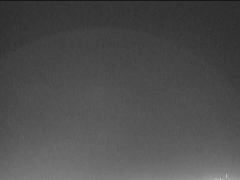[/caption]
Meteor showers are great fun. The streaks and flashes create a special type of astronomical fireworks. But there are some people out there who enjoy meteor showers in a different way. They don’t watch the meteors. Instead, they watch the moon. There are fireworks there, too, in the form of explosions — equivalent to about 100 pounds of TNT — when meteors hit the lunar surface.
On August 9th, during the Perseid meteor shower, a couple of amateur astronomers fixed their cameras on the Moon and watched meteoroids slam into the lunar surface. Silent explosions produced flashes of light visible a quarter of a million miles away on Earth. It was a good night for “lunar Perseids.”

“I love watching meteor showers this way,” says George Varros, who recorded the impact shown above from his home in Mt. Airy, Maryland. The flash, which lit up a nighttime patch of Mare Nubium (the Sea of Clouds), was a bit dimmer than 7th magnitude, which Varros said was “an easy target for my 8-inch telescope and low-light digital video camera.”
Hours later, another Perseid struck, on the western shore of Oceanus Procellarum (the Ocean of Storms). This time it was Robert Spellman of Azusa, California, who caught the flash. “It’s exciting to witness these explosions in real time,” he says. “I used a 10-inch telescope and an off-the-shelf Supercircuits video camera.” Spellman has a website about his observations.
NASA’s Meteoroid Environment Office watches the moon during meteor showers, too. Rob Suggs at the Marshall Space Flight Center and his team have recorded more than 100 lunar explosions since 2005. “We monitor lunar meteors in support of NASA’s return to the Moon,” Suggs says. “The Moon has no atmosphere to protect the surface, so meteoroids crash right into the ground. Our program aims to measure how often that happens and answer the question, what are the risks to astronauts?”
But NASA’s official lunar meteor observatories in Alabama and Georgia were both off-line on August 9, so the NASA team didn’t see how many Perseids were hitting the Moon that night.
“This shows how amateur astronomers can contribute to our research,” points out Suggs. “We can’t observe the Moon 24-7 from our corner of the USA. Clouds, sunlight, the phase of the Moon—all these factors limit our opportunities. A global network of amateur astronomers monitoring the Moon could, however, approach full coverage.”
Suggs hopes other amateurs will take up this hobby of watching the moon during meteor showers, not only to improve NASA’s lunar impact statistics, but also to support the agency’s LCROSS mission: In 2009, the Lunar CRater Observation and Sensing Satellite (LCROSS) will intentionally dive into the Moon, producing a flash akin to a natural lunar meteor. Unlike natural meteoroids, which hit the Moon in random locations, LCROSS will carefully target a polar crater containing suspected deposits of frozen water. If all goes as planned, the impact will launch debris high above the lunar surface where astronomers can search the ejecta for signs of H2O. The impact flash (if not hidden by crater walls) and the debris plume may be visible to backyard telescopes on Earth. Here’s more details on the LCROSS impact.
If you’re interested in watching for meteor impacts on the moon, NASA has a FAQ page, and telescope tips.
News Source: Science@NASA


Very nice indeed! I’m a serious observer of the Moon, so would love to catch something like this.
These two regions – Mare Nubium and Oceanus Procellarum – are predominantly made up of dark lava deposits, however, any recent, but significant, impact onto their surface would cause lighter material underneath to be ejected around the crater formed.
These are significant flashes, which might mean significant pieces of meteoroids sizes.
As current amateur telescopes should be able to see very small craters formed, has anyone come across serious reports of new, recent craters found on the Moon? NASA’s Meteoroid Environment Office does, after all, report upto 103 flashes observed since 2005, so surely someone, somewhere has spotted something in these last three years)?
John — http://www.moonposter.ie
(a detailed poster on important aspects about the Moon)
very cool. i never thought to do it before. thanks for the idea.
That’s no moon…
I am wondering how the future permanent settlements on the Moon will solve this problem. Because it is a real problem! The blueprints or the mockups we can see so far do not seem to take the meteor showers into consideration. Structures that are partially underground could not withstand such impacts.
The ISS isn’t protected by an atmosphere and so can serve as an experiment in meteor dodging. With the solar panels, it’s probably about the size of a small moon base. I’m sure they’ll put the main living and working areas for the moon base underground, but some of the base will surely be exposed. By looking at the ISS, they’ll be able to gauge the frequency of micrometeroid impacts as well. (Good luck up there!)
zip